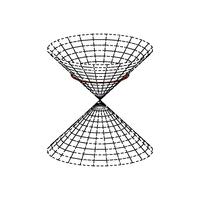Null vector

Hi there, little one! Today we're going to talk about something called a null vector.
Imagine you have a toy car that can go in different directions. If you want it to go straight ahead, you might say, "Go forward!" But what if you wanted to say, "Don't go anywhere at all"? You might say, "Stay in place!" That's kind of like what a null vector is.
You see, when we're talking about vectors, we're usually talking about things that have both direction and magnitude. That means they're like arrows that point in a certain direction and have a certain length. But sometimes, we might want to talk about something that doesn't have a direction or magnitude at all. That's where the null vector comes in.
The null vector is like the "do nothing" vector. It points in no particular direction, and it has no magnitude. You might think of it as a point in space that doesn't go anywhere. It's kind of like telling your toy car to stay in place instead of moving.
Now, you might be wondering why anyone would bother with a vector that doesn't go anywhere. It might seem like we're just wasting our time! But actually, null vectors can be really useful in math and physics. For one thing, they help us define certain properties of other vectors. We can use them to see how a vector changes when we add or subtract another vector, for example.
So even though null vectors don't seem to do anything, they're actually really important tools for understanding how other vectors work. Pretty cool, huh?
Imagine you have a toy car that can go in different directions. If you want it to go straight ahead, you might say, "Go forward!" But what if you wanted to say, "Don't go anywhere at all"? You might say, "Stay in place!" That's kind of like what a null vector is.
You see, when we're talking about vectors, we're usually talking about things that have both direction and magnitude. That means they're like arrows that point in a certain direction and have a certain length. But sometimes, we might want to talk about something that doesn't have a direction or magnitude at all. That's where the null vector comes in.
The null vector is like the "do nothing" vector. It points in no particular direction, and it has no magnitude. You might think of it as a point in space that doesn't go anywhere. It's kind of like telling your toy car to stay in place instead of moving.
Now, you might be wondering why anyone would bother with a vector that doesn't go anywhere. It might seem like we're just wasting our time! But actually, null vectors can be really useful in math and physics. For one thing, they help us define certain properties of other vectors. We can use them to see how a vector changes when we add or subtract another vector, for example.
So even though null vectors don't seem to do anything, they're actually really important tools for understanding how other vectors work. Pretty cool, huh?
